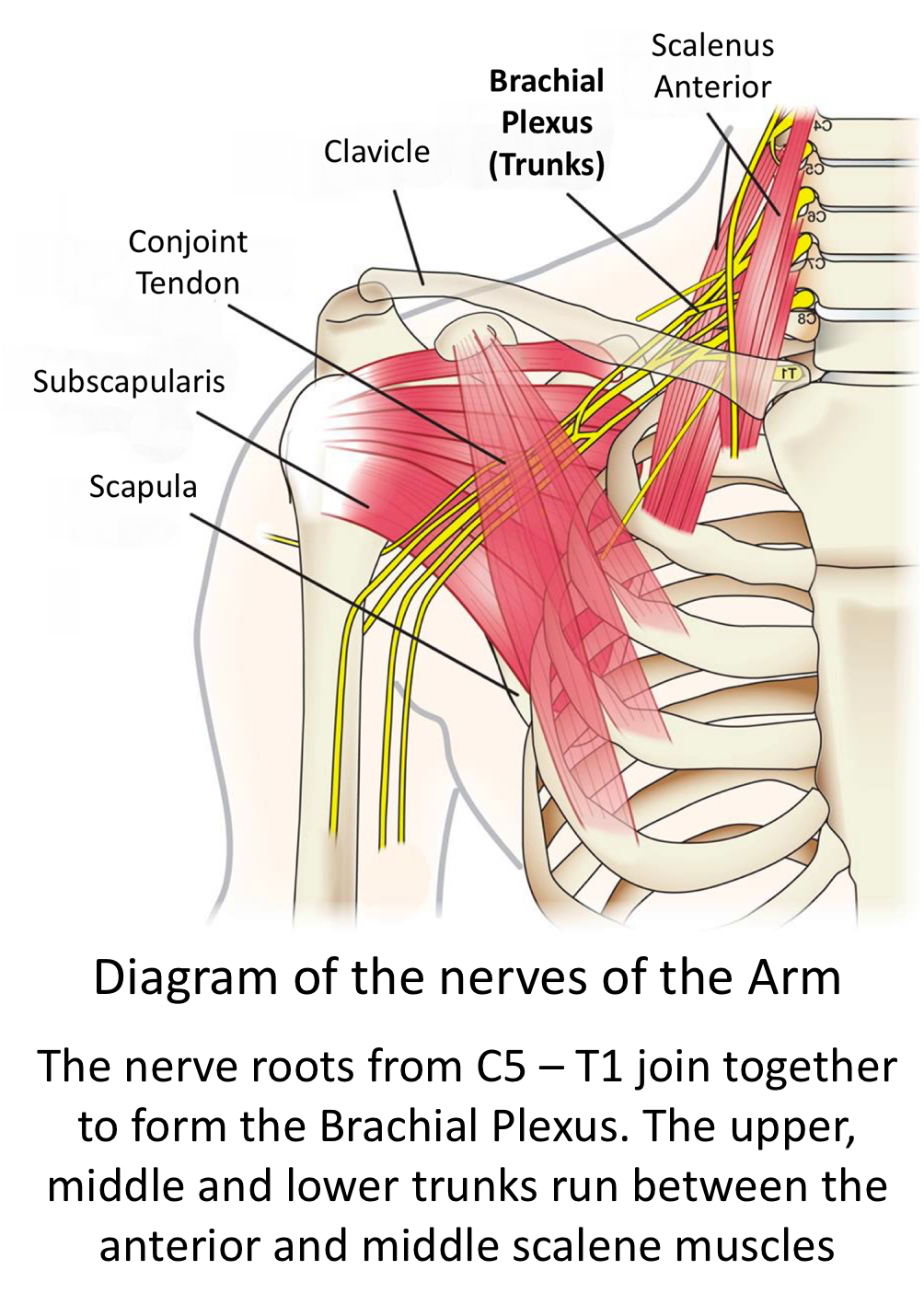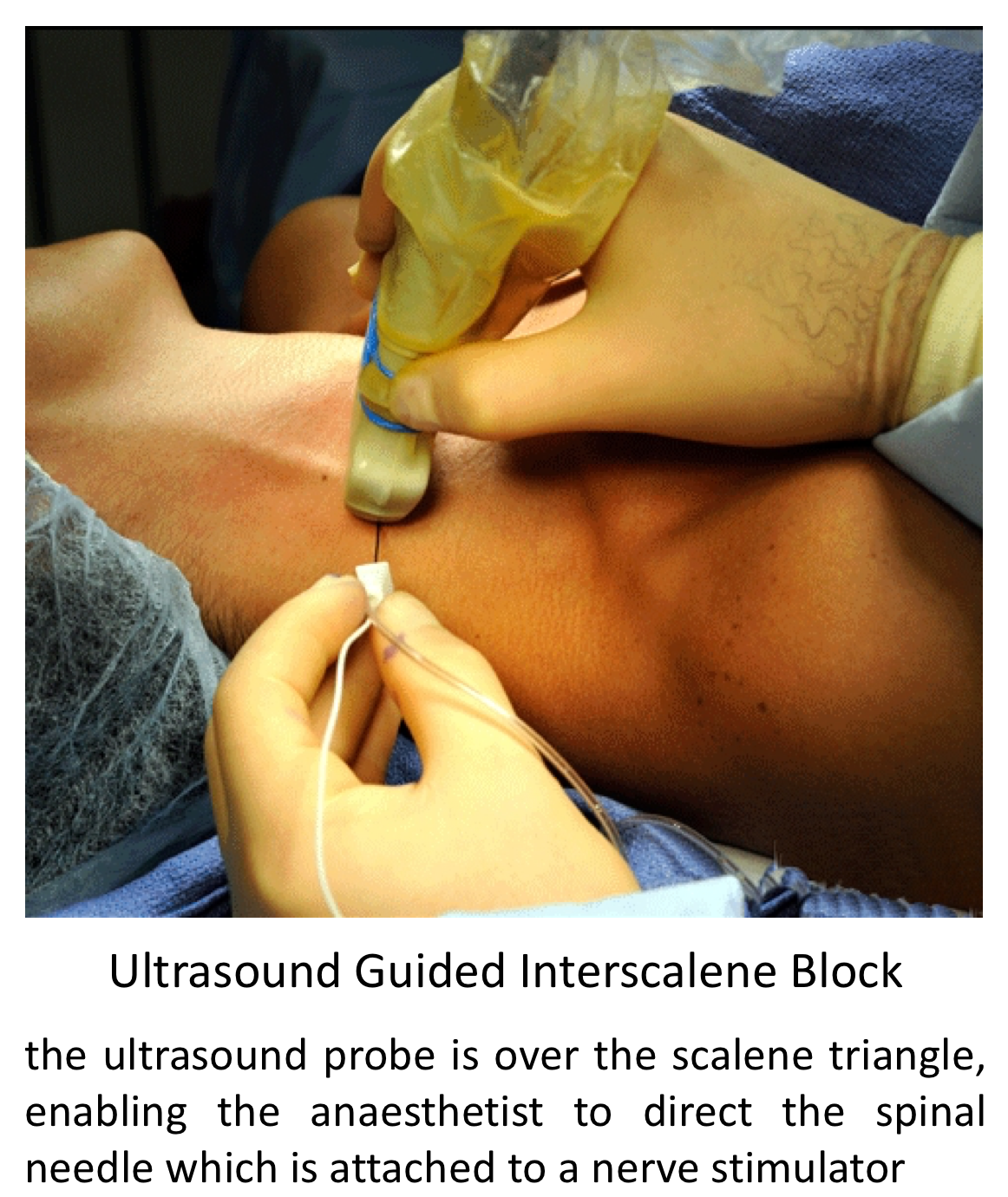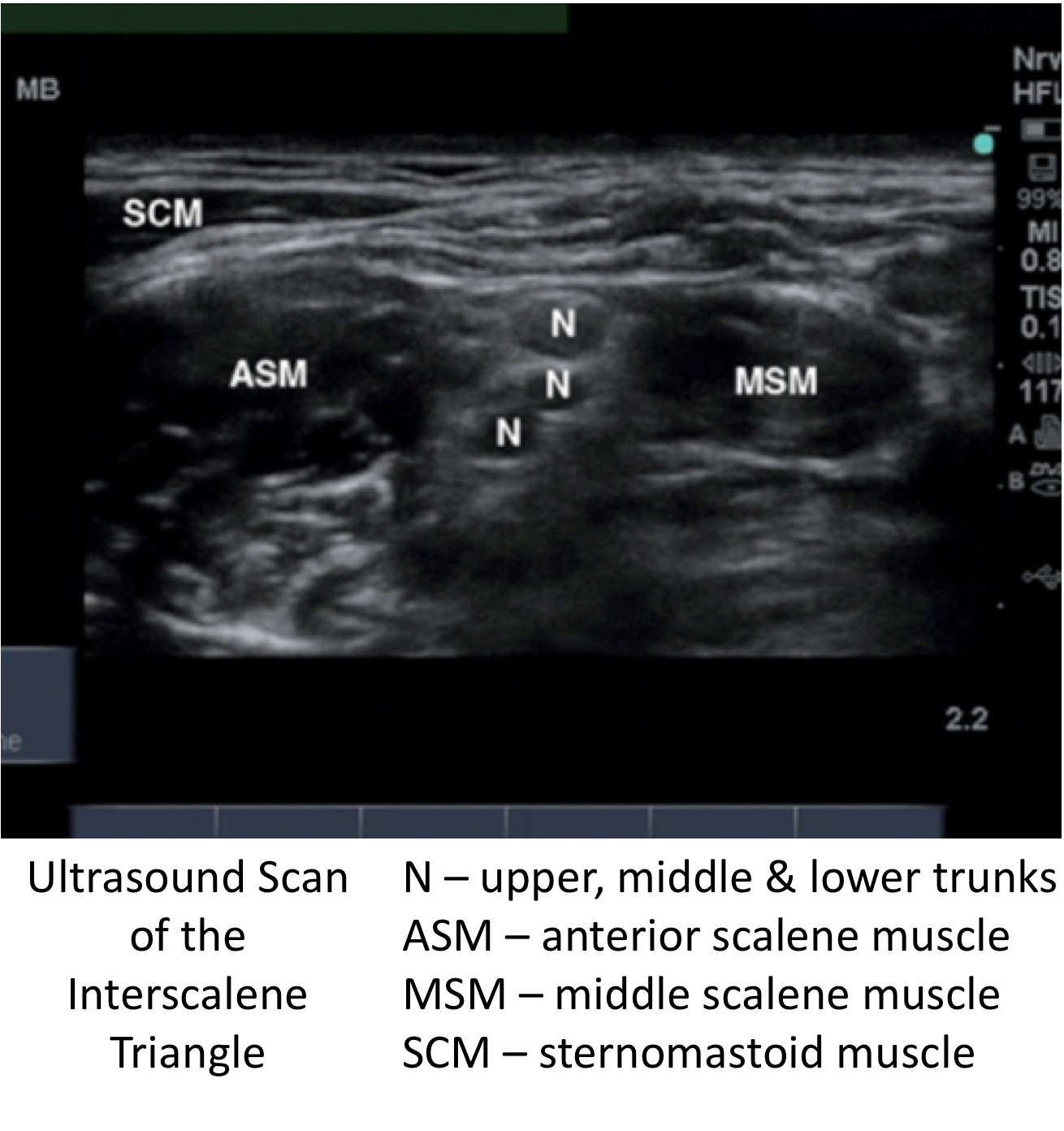Anaesthetics for Shoulder Surgery
Types of Anaesthetics
Anaesthesia stops the feeling of pain and other sensations. Anaesthetics can be given in various ways.
- Local Anaesthesia
- this involves injecting small volumes of local anaesthetic into a small area of the body. This will numb the area whilst the patient remains conscious.
- Regional Anaesthetic
- this involves injecting local anaesthetic around a specific nerve or groups of nerves
- this will anaesthetise the nerve and temporarily stop the nerve from working
- the effect of this is that the whole area of the body supplied by that nerve will be numbed, whilst the patient remains conscious
- the most common regional anaesthetic for Shoulder Surgery is an Interscalene Nerve Block
Find out more about Interscalene Nerve Blocks….
- General Anaesthetic
- a general anaesthetic creates a state of controlled unconsciousness and is essential to perform certain operations
- the patient is unconscious, so asleep, and cannot feel anything
- when the patient wakes up they cannot remember anything about their operation
- there are many different types of general anaesthetic, the choice of which may depend on patient factors and the type of operation being performed
- as a rule, a general anaesthetic involves the use of anaesthetic drugs given both intravenously and by gas
Find out more about General Anaesthetics….
General Anaesthetic
What is a General Anaesthetic?
- General Anaesthesia is a state of controlled unconsciousness
- Medications, given intravenously and by gases, are used to put the patient asleep and to keep them asleep
- With a General Anaesthetic the patient is completely unaware of their surgery and feels no pain
- General Anaesthesia is essential for some surgical procedures where it is safer and more comfortable for the patient to be asleep
- A General Anaesthetic is used for most shoulder operations with an additional Interscalene Nerve Block. This ensures the best post-operative pain relief
Find out more about Interscalene Nerve Blocks….
How is a General Anaesthetic given?
- Before an Operation
- A Consultant Anaesthetist will always meet with and assess a patient before their operation
- The Consultant Anaesthetist will check the patient’s medical records and examine them for their suitability for an anaesthetic
- They will also ask the patient about their general health and lifestyle including,
- any regular medications that they are taking
- any allergies
- smoking & drinking
- The Consultant Anaesthetist can answer ANYquestions or concerns about any aspect of having a general anaesthetic
- Ultimately it is the decision of the Consultant Anaesthetist as to what is the most appropriate and safest General Anaesthetic for a particular patient
- The patient will be given clear instructions with regards to eating or drinking in the hours before their operation
- During the Operation
- When the patient goes down to the operating suite they will first be taken into a separate anaesthetic room, where they will meet the Consultant Anaesthetist and his team
- Usually an intravenous cannula is inserted into the patient’s arm and various blood pressure, heart and breathing monitors applied
- The General Anaesthetic is usually ‘induced’ by injecting anaesthetic drugs through the cannula
- The Anaesthetic should take effect very quickly (within seconds) and the patient will initially feel light-headed and then become completely unconscious
- A laryngeal mask or endotracheal tube will then be inserted and anaesthetic gases will then be administered
- The anaesthetic gases are used to maintain the anaesthetic and can be adjusted by the anaesthetist in response to any changes in the patient’s monitoring
- If an Interscalene Nerve Block is going to be used, it is then given
- The Consultant Anaesthetist remains with the patient for the whole time during their procedure
- The end of the Operation & Recovery
- At the end of the procedure the anaesthetic gases are switched off and the patient gradually regains consciousness
- The Interscalene Nerve Block should make the patient comfortable when they wake up, but additional intra-venous painkillers can also be given, if required
- The patient will then be taken through to the Recovery Room where a Recovery Nurse, assigned to an individual patient, will monitor and care for the patient as they recover from the anaesthetic
- Once the patient has fully recovered from their anaesthetic and is completely awake and comfortable they will be transferred back to their room on the ward
Who is the Consultant Anaesthetist?
- One of the benefits of undertaking surgery in the Independent/Private sector is that I choose who the Consultant Anaesthetist is for my patients
- I work with a small group of highly trusted and experienced Consultant Anaesthetists who are specialist in Musculoskeletal or Cardiothoracic Anaesthetics and Interscalene Nerve Blocks
Download an Information Leaflet….
What are the side-effects of a General Anaesthetic?
- General Anaesthetics have some common transient side-effects which the Consultant Anaesthetist will have discussed before the procedure
- Most side-effects occur in the immediate post-operative recovery period and usually do not last for long and include,
- Feeling Sick & Vomiting –this usually occurs immediately. Various strong ant-sickness drugs can be given by the Recovery Nurses to help with this
- Shivering & Feeling Cold – this may last a few minutes or up to a couple of hours
- Confusion & Memory Loss –this tends to be more common in older patients and those with existing memory problems. It is usually temporary but can be longer lasting
- Bladder Problems - some patients can have issues with passing urine
- Dizziness – this is often due to an element of dehydration and fluids can be given to help this
- Sore Throat - during the procedure a tube is inserted into the patients mouth or throat to administer the anaesthetic. This can result in some temporary soreness
Complications and Risks of a General Anaesthetic
- A number of serious potential complications are associated with a General Anaesthetic. These are rare and occur in less than 1 in every 10,000 cases
- Possible complications and risks include,
- Anaphylaxis - a serious allergic reaction
- An inherited reaction – there are a very few occasions where a patient has an inherited problem that may lead to an adverse reaction to certain anaesthetic drugs
- Death – this is a very rare complication and occurs in less than 1 in 100,000 – 200,000 cases
Interscalene Nerve Block
What is it?
- An interscalene nerve block is an injection of local anaesthetic around a group of nerves, known as the brachial plexus, at the base of the neck
- The Brachial Plexus nerves branch out and supply sensation, feeling and movement to the shoulder and the whole of the arm
- The local anaesthetic ‘blocks’ these nerves, temporarily, and takes away all of the feeling and sensation of pain and movement in the shoulder and arm
What are the Benefits?
- Shoulder surgery can be painful, particularly in the first 12 – 24 hours after an operation
- An interscalene nerve block can significantly reduce, or even remove, any pain over this period
- An interscalene nerve block is the most effective way of controlling and preventing pain immediately after surgery
- It avoids the requirement of large amounts of strong painkillers, which can lead to drowsiness and sickness
- It makes the recovery from surgery more pleasant and can help to get patients home more quickly
How is an Interscalene Nerve Block performed?
- An interscalene nerve block is undertaken by a Consultant Anaesthetist at the time of the General Anaesthetic
- It is usually administered after the General Anaesthetic has started and so the patient is asleep
- Using an ultrasound machine the anaesthetist is able to accurately visualise the brachial plexus nerves where they sit between the scalene muscles
- Under ultrasound control, having sterilised the area, a needle is inserted into the sheath that surrounds the brachial plexus nerves
- The needle is attached to a nerve stimulator device that gives additional information as to the accuracy of its position
- Once the anaesthetist is happy that the needle is in the correct position 20 – 30ml of local anaesthetic is injected into the sheath surrounding the nerves
Find out more about Interscalene Nerve Blocks….
What does the Shoulder feel like after an Interscalene Nerve Block?
- The shoulder and the whole of the arm feel completely numb after an interscalene nerve block
- Additionally, the arm is temporarily, partially paralysed so the patient is unable to move their shoulder, elbow and hand
- The patients arm is kept in a sling to protect it and hold it in position whilst the block is working
How long does an Interscalene Nerve Block last?
- The block usually lasts between 18 – 24 hours
- The block tends to gradually wear off over time
- ‘pins and needles’ initially develops in the fingers, followed by recovery of sensation and movement which slowly progresses up the arm to the shoulder
- There is likely to be an element of residual pain in the shoulder once the block has worn off and patients are given oral painkillers over this period, to make this transition comfortable
What are the Risks and Side-Effects of an Interscalene Nerve Block?
- Occasionally interscalene nerve blocks are not always completely effective, usually because the local anaesthetic has not completely spread to all of the nerves
- If the block is not adequately able to control the discomfort additional pain killers will always be given
- Sometimes the local anaesthetic can spread to other nerves close to the brachial plexus. This can result in a droopy eyelid, a hoarse voice and difficulty in taking a deep breath
- All of these side-effects are temporary and will completely recover once the block has worn off
- Nerve damage due to injury to the nerve, bleeding around the nerve or infection is extremely rare complication and occurs in about 1 in 30,000 patients
Do you have to have an Interscalene Nerve Block & who can I talk to about it?
- Although it is strongly advised that someone should have an interscalene nerve block when they undergo shoulder surgery it is not essential and, not having one, will not be detrimental to the ultimate success of the procedure
- If an interscalene nerve block is not used, a patient’s pain and discomfort after their surgery can easily be controlled, but usually requires additional painkillers
- Prior to a Shoulder operation the Consultant Anaesthetist will always meet and assess the patient and discuss fully the options, suitability and risks with regards to both a general anaesthetic and an interscalene nerve block
- There are certain conditions where an interscalene nerve block might be contra-indicated. These include previous brachial plexus nerve injuries, certain neck problems and some nerve conditions
Can you have a Shoulder Operation with an Interscalene Block on its own?
- Yes – it is possible to have a shoulder operation with an interscalene nerve block on its own and without a general anaesthetic
- Generally, it is not recommended as it can take some time for the block too work and most patients prefer to be a sleep when having an operation
- However, there are a few conditions where medically avoiding a general anaesthetic is preferred or where a patient particularly does not want a general anaesthetic






